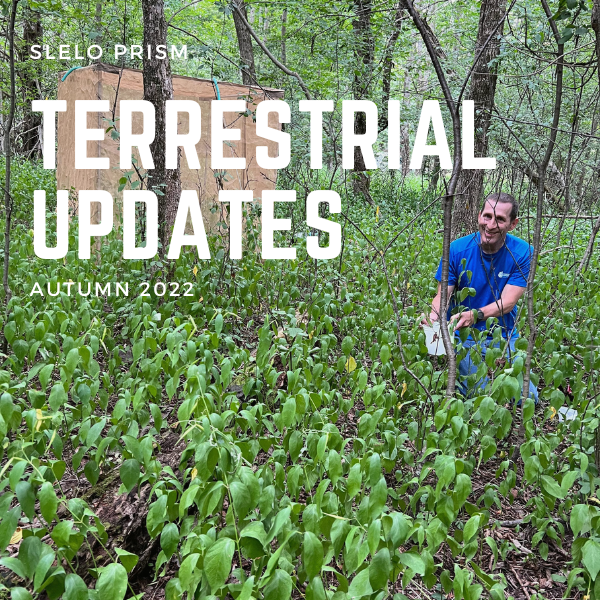This article was featured in the 2022 Autumn Newsletter by Robert Smith-SLELO PRISM.
Managing for Resilience: Suppression of Terrestrial Plants.
Control work to date has resulted in the following metrics.
Giant Hogweed:(Heracleum mantegazziamum)
- 44 Total Sites Monitored
- 27 Sites with no germination
- 4 Retired
- 4 Site root cut
- 11 Sites herbicide treatment
- 2 Site with no permission to treat
Swallow-wort: (Cynanchum spp.)
- 56 Sites managed on 13 PCAs
- 97.69 Acres under management (HPA)
- 25.14 Acres of Presence Area
Phragmites: (Phragmites australis)
- 12 Sites managed on 7 PCAs
- 12.55 Acres under management
- 1.43 Acres of Presence Area
Japanese Knotweed: (Fallopia japonica)
- 9 Sites are being managed on 3 PCAs
- 10.49 Acres under management (HPA)
- 2.31 Acres of Presence Area
Oriental Bittersweet:
(Celastrus orbiculatus)
10 Sites managed on 2 PCAs
- 10.97 Acres under management
- 6.93 Acres of Presence Area
Yellow Iris: (Iris pseudacorus)
- 2 Sites managed on 2 PCAs
- 1.3 Acres under management
- 0.21 Acres of Presence Area
Early Detection Efforts
No Tier 1 or New Tier 2 Species Found
Continuing on a two-year rotation, this year (2022) early detection efforts were completed in the following Priority Conservation Areas.
- Black Pond WMA (B)
- Chaumont Barrens Preserve (T)
- Chaumont Bay (A)
- Deer Creek WMA (B)
- El Dorada Preserve (T)
- Lakeview WMA (B)
- Oneida Lake and Three Mile Bay WMA (B)
- Salmon River Estuary (A)
(A = Aquatic, T = Terrestrial, B = Both)
Terrestrial Restoration Sites
To increase the resiliency of select post-treatment sites we often plant seed at these sites to expedite native re-growth. We select seeds that match the ecological community and are present in the region. Data such as % grasses, sedges/rushes, forbs, shrubs, and trees are then recorded in randomly selected 1m2 vegetation plots. These sites along with additional sites that we select in future years will be monitored and surveyed pre-seeding and post-seeding annually. Sites restored this year include- El Dorado Preserve, Black Pond WMA, Deer Creek WMA, and Three Mile Bay WMA.
Hypena opulenta Release
This year, we completed another biocontrol release of Hypena opulenta moths at Wehle State Park and Grenadier Island. These moths are native to Ukraine and feed exclusively on pale and black swallow-wort in their larval form. On June 6, we placed 20 adults in each of four cages (2 at Wehle State Park, and 2 at Grenadier Island). Like last year, the first generation produced few larvae, so we waited for this generation to pupate, emerge as adults and lay eggs. We had modest success with the second generation with the best results occurring at Cage 2 on Grenadier Island (60% defoliation) and the second best at Cage 1 at Wehle State Park (40% defoliation). To further our efforts in establishing this biocontrol, we purchased an additional 440 larvae and 76 pupae from the Phillip Alampi Beneficial Insects Laboratory. On August 4, we released 110 larvae 10 feet from each cage and placed 19 pupae in each cage.

In addition, we have engaged residents of Grenadier Island and the New York State Office of Parks, Recreation, and Historic Preservation (NYS OPRHP) to improve our overwintering surveys. A Hypena opulenta moth identification video has been made to help the residents of Grenadier Island that plan to look for signs of the establishment. We are also working with NYS OPRHP to organize an overwintering trail survey at Wehle State Park. Our hope is that more people looking for evidence of Hypena opulenta moth presence will increase the chance that we find establishing populations.
Biological Control of Emerald Ash Borer
This year, we were approved by the USDA to release EAB biocontrol insects at Rice Creek Field Station at SUNY Oswego. As part of this USDA program, the releases will occur for two years. This year, we had 8 releases from June-August, and will be releasing a similar number next year.
The type of biocontrol being released is parasitoid wasps and the USDA provided us with 3 species. Release sites will be followed-up on by an establishment survey a year after the second release.
The total number of each release is as follows:
- Spathius glainae: 1137
- Tetrastichus planipennisi: 3352
- Oobius galinae: 1200
Grand Total: 5689



